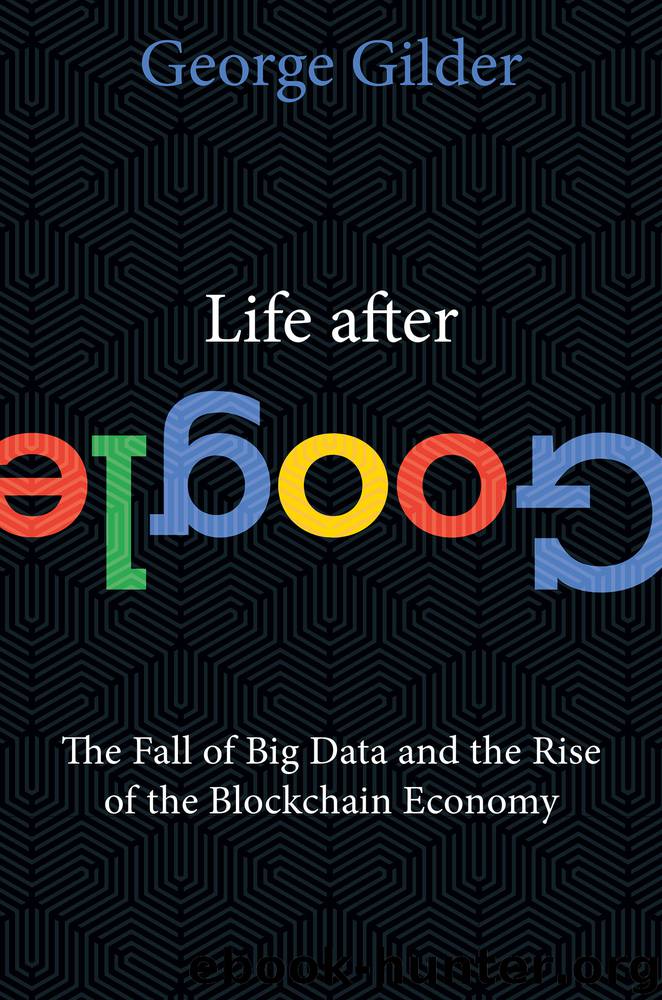Life After Google by George Gilder

Author:George Gilder
Language: eng
Format: epub
Publisher: Gateway Editions
CHAPTER 14
Blockstack
It all begins with the “Metaverse” in Neal Stephenson’s 1992 novel Snow Crash,1 a vision of a virtual world on top of the real world. A quarter-century later it still excites geek romantics with its prophetic music:
When Hiro first saw this place 10 years ago, the monorail hadn’t been written yet. He and his buddies had to write car and motorcycle software in order to get around. They would take their software out and race it in the black desert of the electronic night.2
Muneeb Ali quotes this passage from from Snow Crash in the opening of his magisterial dissertation, “Trust-to-Trust Design of a New Internet,” the product of his work with Ryan Shea and Jude Nelson and their Princeton adviser, Michael J. Freedman.3 This team went out into the electronic night and attempted to light it up with an architecture for a transformed Internet—a metaworld of trust beyond the seven layers of communications technology.
Ali, the key figure in this audacious project, called Blockstack, has come a long way since he first encountered the Internet at the age of twelve in Pakistan. As a reward for getting all As in school, his mother had given him a computer. The boy was grateful and excited. Although his father was a director of military intelligence in his country, the family was not rich. Buying the computer meant delaying the purchase of a washing machine.
“What kind of computer was it?” I asked him fifteen years later, in 2017, in Blockstack’s offices on Great Jones Street, near the Bowery in Manhattan.
“Oh, it was an Intel 386.”
“Yes,” I said, “that’s the microprocessor, but what brand of computer was it? What company made it?”
Ali looked baffled, then responded, “Oh, I don’t know. I assembled the computer myself.”
I realized we were talking serious twelve-year-old Pakistani tech talent here. In a TED talk PowerPoint he presented in Manhattan in 2016, we can see him in a photo some fifteen years before, a diminutive boy wearing the red shorts and shirt of a medallioned school uniform, with his right arm around his younger brother.4 Gaining strength from each other, they are standing on a wooden span across a turbid river in Pakistan, a metaphorical bridge between different worlds of culture and technology.
The little boy who put together that modern computer would grow up to reimagine a global network. But to break away would take audacity and ingenuity. The other end of the bridge offered no safe havens or guarantees, no more than it does now for his new trust-to-trust model of the Internet.
Ali went on to study computer science at Lahore University Management School. Taking his degree in 2005, he saw few opportunities in Pakistan, so he concocted a bold plan to obtain a fellowship at the Swedish Institute of Computer Science in Stockholm. The Swedes were happy to have him but offered no financial support. Frustrated, with no money and no job, Ali considered retreating back over the bridge, but his bias is always to keep moving ahead.
He conceived a stratagem—a kind of bridge loan that might take him forward.
Download
This site does not store any files on its server. We only index and link to content provided by other sites. Please contact the content providers to delete copyright contents if any and email us, we'll remove relevant links or contents immediately.
Life 3.0: Being Human in the Age of Artificial Intelligence by Tegmark Max(5506)
The Sports Rules Book by Human Kinetics(4338)
The Age of Surveillance Capitalism by Shoshana Zuboff(4241)
ACT Math For Dummies by Zegarelli Mark(4016)
Unlabel: Selling You Without Selling Out by Marc Ecko(3622)
Blood, Sweat, and Pixels by Jason Schreier(3583)
Hidden Persuasion: 33 psychological influence techniques in advertising by Marc Andrews & Matthijs van Leeuwen & Rick van Baaren(3515)
Bad Pharma by Ben Goldacre(3395)
The Pixar Touch by David A. Price(3389)
Urban Outlaw by Magnus Walker(3363)
Project Animal Farm: An Accidental Journey into the Secret World of Farming and the Truth About Our Food by Sonia Faruqi(3188)
Kitchen confidential by Anthony Bourdain(3044)
Brotopia by Emily Chang(3024)
Slugfest by Reed Tucker(2968)
The Content Trap by Bharat Anand(2884)
The Airbnb Story by Leigh Gallagher(2820)
Coffee for One by KJ Fallon(2598)
Smuggler's Cove: Exotic Cocktails, Rum, and the Cult of Tiki by Martin Cate & Rebecca Cate(2493)
Beer is proof God loves us by Charles W. Bamforth(2412)
